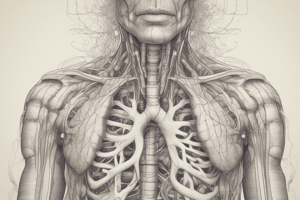Podcast
Questions and Answers
Which gas law states that at constant temperature, the volume of a gas is inversely proportional to its pressure?
Which gas law states that at constant temperature, the volume of a gas is inversely proportional to its pressure?
- Graham's Law
- Boyle's Law (correct)
- Charles's Law
- Dalton's Law
What is the primary role of the diaphragm during breathing?
What is the primary role of the diaphragm during breathing?
- To assist in gas exchange in the alveoli
- To increase lung volume during exhalation
- To create negative pressure in the thoracic cavity during inhalation (correct)
- To relax the airways for increased airflow
Which structure primarily regulates the rhythmic pattern of breathing?
Which structure primarily regulates the rhythmic pattern of breathing?
- Medulla oblongata (correct)
- Thalamus
- Cerebellum
- Pons
Which histological feature is characteristic of the trachea but is absent in the bronchioles?
Which histological feature is characteristic of the trachea but is absent in the bronchioles?
How do the factors such as pH and carbon dioxide concentration influence respiration?
How do the factors such as pH and carbon dioxide concentration influence respiration?
Study Notes
Anatomy and Histology of the Respiratory Tract
- The respiratory tract consists of the upper and lower respiratory tracts, including nasal cavity, pharynx, larynx, trachea, bronchi, and lungs.
- Histologically, the trachea and bronchi have ciliated pseudostratified columnar epithelium to trap foreign particles and facilitate movement of mucus.
- The alveoli, where gas exchange occurs, are lined with simple squamous epithelium, optimizing diffusion due to minimal thickness.
- Structural changes occur during inspiration (air in) and expiration (air out), leading to expansion and contraction of the thoracic cavity.
Gas Laws Related to Respiration
- Boyle's Law: At constant temperature, the pressure of a gas is inversely proportional to its volume; as lung volume increases, intrapulmonary pressure decreases, allowing air to enter.
- Charles's Law: At constant pressure, the volume of a gas is directly related to its temperature; as air warms in the lungs, it expands, aiding in gas exchange.
- Dalton's Law: The total pressure of a mixture of gases equals the sum of the partial pressures of each gas; this is crucial for understanding how oxygen and carbon dioxide are exchanged.
Contribution of Individual Muscles to Breathing
- Diaphragm: Main muscle of inspiration that contracts and moves downwards, increasing thoracic volume.
- Intercostal Muscles: External intercostals assist with inhalation by elevating the ribs, while internal intercostals aid exhalation by depressing the ribs.
- Accessory Muscles: Neck and abdominal muscles assist in forced breathing; scalenes and sternocleidomastoid elevate the rib cage, while abdominal muscles help expel air during active exhalation.
Neural Mechanisms Controlling Breathing
- The medulla oblongata and pons in the brainstem regulate involuntary breathing patterns.
- Chemoreceptors sensitive to CO2, O2, and pH levels in the blood help adjust the rate and depth of breathing based on metabolic needs.
- The phrenic nerve stimulates the diaphragm, while intercostal nerves activate intercostal muscles, coordinating rhythmic breaths.
Studying That Suits You
Use AI to generate personalized quizzes and flashcards to suit your learning preferences.
Description
Test your knowledge on the anatomy and histology of the respiratory tract, including functional changes. Explore the three gas laws relevant to respiration and identify the muscle actions involved in breathing. Additionally, understand the neural mechanisms that regulate the process of respiration.




